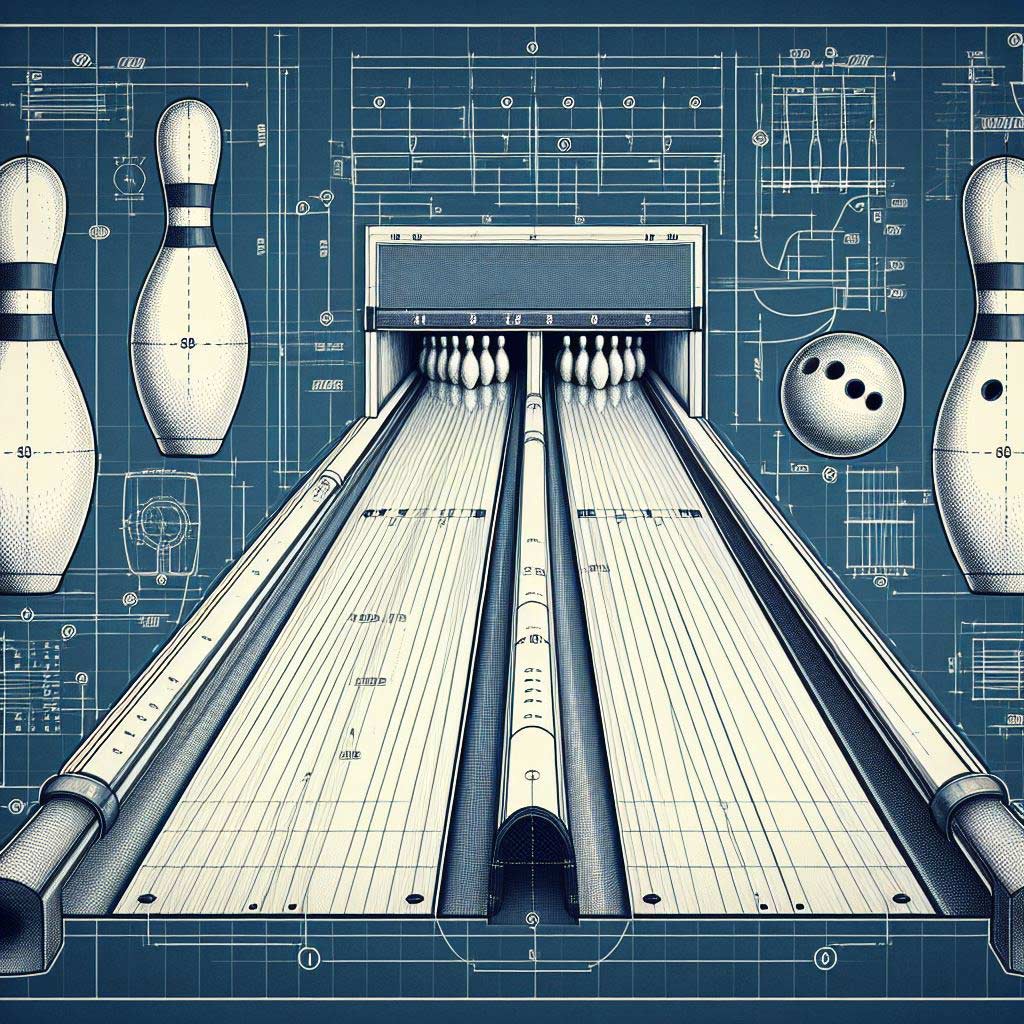Bowling is one of the most popular sports in the world, with over 90 million people participating globally. As a sport that relies on rolling a ball down a narrow lane to knock down pins, having proper lane dimensions is crucial for fair play.
The length, width, and other specifications of bowling lanes have been standardized worldwide by major bowling organizations and federations. Understanding the regulation of bowling lane dimensions is important whether you are a casual bowler or a professional player.
In this comprehensive guide, we will cover all the key dimensions and sizes related to regulation bowling lanes. You’ll learn about the lengthwise sections like the approach, lane, and pin deck.
We’ll also discuss the widthwise sections including gutters and crown areas. You’ll find the regulation dimensions for each part of a ten-pin bowling lane.
We’ll also look at approach area size, pin deck layouts, lane oil patterns, and how they impact bowling strategy. By the end, you’ll understand the standardized bowling lane sizes and why they are so important for uniformity in the sport.
Regulation Lane Dimensions
The first pin spot in a regulation ten-pin bowling lane is 60 feet from the foul line where bowlers release the ball. This distance of 60 feet from the foul line to the headpin spot is the official length of a bowling lane.
The lane width of a regulation bowling lane is 42 inches across. This width spans from edge to edge, covering the lane surface between the two gutters.
These 60 feet by 42 inches dimensions are sanctioned by the World Bowling Organization and United States Bowling Congress as the standard specifications for tenpin bowling lanes worldwide. All certified bowling lanes must follow these length and width regulations precisely.
Some other important regulation specs for bowling lanes are:
- Gutter width – Max width is 3.5 inches on each side
- Lane surface crowns – Can have up to 0.040-inch crowns
- Approach area length – Minimum 15 feet from the foul line
The precisely defined dimensions ensure that competitive bowling is played on a standardized field, much like official sizes for basketball courts or football fields. Whether you are bowling for fun or in a tournament, you can expect regulation lane dimensions.
Parts of a Bowling Lane
Bowling lanes have lengthwise and widthwise sections that each serve a specific purpose. The main lengthwise parts are the approach area, lane, and pin deck from start to end.
Widthwise, lanes have two gutters flanking the crown lane surface. Let’s look at the function and dimensions of these key bowling lane sections.
Lengthwise Sections
-
Approach Area
The approach area is the section right before the lane where bowlers stand to release the ball. This area is a minimum of 15 feet long from the foul line according to WB and USBC standards. The approach culminates in the foul line, which is the front edge of the flat lane surface.
-
Lane
The lane itself extends from the foul line to the start of the pin deck where the pins are set up. Regulation lanes are 60 feet long from the foul line to the headpin as mentioned earlier. The lane also meets the 42-inch width specification.
-
Pin Deck
This is the zone where the pins are arranged for bowling. It extends from the end of the actual lane to the pit where knocked-down pins go. The length and layout of the pin deck are highly regulated, which we’ll explore more in a later section.
Widthwise Sections
-
Gutters
The two gutters flank each side of the lane surface. They are narrow channels that divert balls and prevent pins from being hit from an angle. Gutter width can’t exceed 3.5 inches on each side based on official standards.
-
Crown
The crown refers to the slight elevation in the center of the lane widthwise. It helps guide the ball to the center. Regulation lane crowns cannot exceed 0.040 inches in height. Too high of a crown can negatively impact rolling.
The combination of these lengthwise and widthwise sections with adherence to regulation dimensions creates a standard bowling lane that provides equal playing conditions.
Approach Area Size Regulations
As one of the most important parts of a bowling lane, the approach area deserves special attention. This is the zone where bowlers start their run-up to release the ball down the lane.
The size of the approach area directly impacts a bowler’s ability to build speed and find the proper launch angle. That’s why there are standards for the length and width of regulation approach areas.
The United States Bowling Congress clearly defines approach area dimensions in its rulebook for optimal play.
- Length – The minimum length of the approach area is 15 feet measured from the foul line to the end of the approach. This gives ample runway for bowlers to make their approach.
- Width – Regulation approach areas must be the same width as the lane, which is 42 inches. Narrower approaches can hamper stance and footwork.
- Condition – The surface must be free of debris and distractions and provide proper traction.
These specifications allow bowlers to have consistent footing and space for their pre-release approach every time. A longer and wider approach is also allowed if the venue desires. But for certified competition, the minimum standard is 15 feet long and 42 inches wide from the foul line.
Pin Deck Area Regulations
While the lane itself gets most of the attention, the pin deck area is also highly regulated to ensure fair play. This is the zone where pins are set up in specific spots and distances for bowling.
The dimensions and layouts of pin decks are governed by World Bowling rules since slight variations can impact ball paths and scoring. Let’s look at some key pin deck measurement regulations.
- Length – The pin deck extends from the end of the actual lane surface to the pit. Total length varies but must accommodate proper pin spacing.
- Pin Spots – Each of the 10 pins must be set on designated spots measured in relation to the headpin. There are exact distances and angles for each pin from the headpin’s center.
- Foul Line Distance – The headpin must be exactly 60 feet from the foul line at minimum. This ties the lane and pin deck together.
- Pin Distances – Pins are set 12 inches apart from center to center. So the distance between adjacent pins is 12 inches.
These pin deck dimensions and layouts have been carefully tested and configured to allow for both high scores and pin scattering. Strictly following the regulations removes any variation between lanes that could alter play.
Oil Patterns on Bowling Lanes
One more key factor that influences bowling is the oil pattern applied to every lane before use. Various oil patterns change how a bowling ball hooks and rolls down the lane.
The oil is applied lengthwise in different concentrations to achieve certain ball reactions. There are some best practices and regulations regarding lane oil patterns.
Typical Oil Patterns
The most common patterns are:
- House Shot – More oil in the middle with drier boards on the edges. Highest scoring.
- Sport Shot – Oil concentrated more toward the edges. Provides greater challenge.
- Challenge Patterns – Highly customized with high ratios of oil to dry boards.
Oil Impacts Bowling Strategy
The concentration and ratio of oiled to dry boards impact how aggressively a ball hooks. Bowlers have to adjust angles, speed, ball choice, and line accordingly.
Lane Oil Pattern Regulations
Governing bodies do regulate certain aspects of oil patterns such as:
- Oil cannot extend past the foul line
- No foreign substance besides USBC-approved oil can be applied
- The oil pattern must extend the entire length and width of the lane surface
So while challenging oil patterns are allowed, they must conform to certain rules for fair competition. Understanding oil patterns is key for adjusting play.
Conclusion
From the foul line to the pins and gutters to the crown, every dimension of a regulation bowling lane has a purpose. The correct sizes and layouts endorsed by international bowling federations ensure that the sport is contested on a level playing field everywhere balls are rolled. Whether bowling for fun or prize money, you can trust the lane specifications.
Knowing bowling lane dimensions helps bowlers optimize their footwork, angles, and mechanics. The approach area, lane length, pin deck layout, and lane oil patterns all influence bowling scores and strategy. But the regulation sizes mean that no bowler has an unfair advantage based on non-standardized lanes.
As bowling continues to grow globally, these dimensions and best practices will be refined and updated. But the dedication to fair competition through uniform lane regulations will remain a keystone of the sport. The next time you bowl, you can appreciate just how much thought has gone into the bowling lane specifications.
Frequently Asked Questions
What are the dimensions of a pro bowling lane?
The regulation dimensions of a professional bowling lane are 60 feet from the foul line to the head pin and 42 inches wide without gutters.
How wide is a bowling lane including gutters?
A standard bowling lane is 42 inches wide. With the maximum legal gutter width of 3.5 inches on each side, the total width including gutters is 49 inches wide.
How much space is needed for a bowling lane?
For a single lane, approximately 13-15 feet of space is needed for the approach area. Plus 60 feet of length for the lane and pin deck. For adequate walk space around it, budget 70 feet long by 15 feet wide.
Can bowling lanes be different lengths?
Regulation bowling lanes should be 60 feet long. Shorter or longer lanes are usually not sanctioned for official competitive play. However some recreational lanes can vary in length.
How much space do you need for 2 bowling lanes?
Two standard bowling lanes side by side require a space approximately 34 feet wide (2 lanes plus 2 gutters and some buffer space) by 70 feet long minimum.
How wide is a Duckpin bowling lane?
Duckpin bowling lanes are 60 feet long but only 28 inches wide, much narrower than tenpin bowling lanes.
How many inches are between bowling pins?
Regulation tenpin bowling pins are set 12 inches apart at the center from adjacent pins.
How many boards across is a bowling lane?
Bowling lanes are made up of 39 individual 1-inch boards across the 42-inch width. The inside 15 boards are the legal playing surface.
What’s the heaviest a bowling ball can be?
The maximum weight for a regulation bowling ball is 16 pounds. Lighter balls like 12-14 pounds are more common for recreational bowling.





